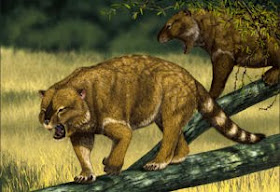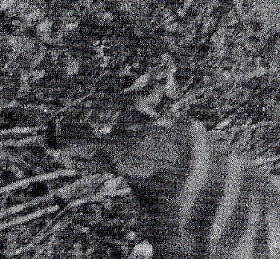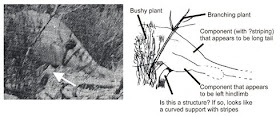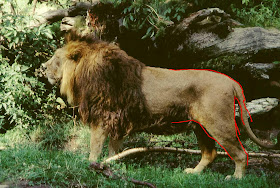
The above photograph, taken in west Victoria in 1964 has caused much confusion. I intend to briefly make my own conclusions on this image. The creature has been nick named the Ozenkadnook tiger or as in this post for abbreviational purposes; Ozzy.
Could it be a Thylacine?


Above; The photograph of the Ozenkadnook tiger (top) compared to the Thylacine (bottom). I have outlined the main shape of the Ozenkadnook tiger to reveal its general morphology. Similarities between the two are the large head and thin tail, but the head shape of Ozzy is much shorter than that of the Tylacine. The back half of Ozzy appears very cat like like, with the back curving down from the shoulders and up to the hips in a concave shape rather than arched. Below is an image of a lion. The red semicircular line indicates the concave curvature of the lions back.
 Could it be a Thylacine? A stripey carnivorous animal that went extinct in the 1930's, but became extinct on the mainland of Australia 2000 years ago. The apparently stripey covering on the Ozenkadnook tiger could be an illusion created by light beams breaking through the canopy and reflecting from the creature. Even if these were stripes they would not indicate a Tylacine identity as it has black rather than white stripes. The creature is most likely not a Thylacine at all due to its shorter snout.
Could it be a Thylacine? A stripey carnivorous animal that went extinct in the 1930's, but became extinct on the mainland of Australia 2000 years ago. The apparently stripey covering on the Ozenkadnook tiger could be an illusion created by light beams breaking through the canopy and reflecting from the creature. Even if these were stripes they would not indicate a Tylacine identity as it has black rather than white stripes. The creature is most likely not a Thylacine at all due to its shorter snout. Could it be a surviving marsupial lion?


 Above; Ozzy (top), Thylacoleo skeleton (middle) and Thylacoleo life reconstruction (bottom). Similarities between Ozzy and Thylacoleo include rather powerful forelimbs, medium sized tail, large head in proportion to body and broad shoulders. Differences include the seemingly and unusually long, broad neck.
Above; Ozzy (top), Thylacoleo skeleton (middle) and Thylacoleo life reconstruction (bottom). Similarities between Ozzy and Thylacoleo include rather powerful forelimbs, medium sized tail, large head in proportion to body and broad shoulders. Differences include the seemingly and unusually long, broad neck.
 Above; the head of Ozzy (top) could well be that of Tylacoleo (bottom). The black line that seems to indicate the lips of Ozzy is resemblant in shape to the carnassialform teeth of Thylacoleo. Just as the cheeks of modern big cats extend to protect the canines so may the cheeks of Thylacoleo have extended downwards to protect its slicing carnassialform teeth. The last marsupial lion; Thylacoleo carnifex died out 49000 years ago so this seems unlikely that Ozzy is one at all. However; the short face seems very reminiscent of the marsupial lion. On the head of the Ozenkadnook beast appears to be a big black nose; rather like that of a wombat (image below). Since both Thylacoleo and the wombats are Diprotodont Marsupials a similar nose is a possible trait shared between the two groups.
Above; the head of Ozzy (top) could well be that of Tylacoleo (bottom). The black line that seems to indicate the lips of Ozzy is resemblant in shape to the carnassialform teeth of Thylacoleo. Just as the cheeks of modern big cats extend to protect the canines so may the cheeks of Thylacoleo have extended downwards to protect its slicing carnassialform teeth. The last marsupial lion; Thylacoleo carnifex died out 49000 years ago so this seems unlikely that Ozzy is one at all. However; the short face seems very reminiscent of the marsupial lion. On the head of the Ozenkadnook beast appears to be a big black nose; rather like that of a wombat (image below). Since both Thylacoleo and the wombats are Diprotodont Marsupials a similar nose is a possible trait shared between the two groups. 
Possible mistaken eye-dentity!
 Above is a diagram of Ozzy's head. A large portion of the face is distorted by foliage making interpretation difficult. Below is another diagram showing what appears to be an eye (circled in blue). This most likely is not an eye, just a piece of reflective foliage resembling an eye. In the diagram above you can see I have marked in orange how this foliage and the head is formed and is indicated by a white patch that continues outside the parameters of the head and clearly separates the "eye" from the actual face.
Above is a diagram of Ozzy's head. A large portion of the face is distorted by foliage making interpretation difficult. Below is another diagram showing what appears to be an eye (circled in blue). This most likely is not an eye, just a piece of reflective foliage resembling an eye. In the diagram above you can see I have marked in orange how this foliage and the head is formed and is indicated by a white patch that continues outside the parameters of the head and clearly separates the "eye" from the actual face.
Or have we all been had!

Above; the photo of Ozzy could just be fake. When you look at the close up of the head in the image above you may notice a white line running around the top of the head. This feature of the photograph seems to indicate that the animal may be cut into the back ground and therefore may be a fake.
 Above is a picture from Darren Naish's Tetrapod Zoology blog pointing out a possible support structure for the creature (suggesting that it could be a model that is being propped up). The stripes on the tail are in my opinion branches of foliage in front of the creature due to their continuous and unbroken path across the surface of Ozzy and even visible presence away from its body surface.
Above is a picture from Darren Naish's Tetrapod Zoology blog pointing out a possible support structure for the creature (suggesting that it could be a model that is being propped up). The stripes on the tail are in my opinion branches of foliage in front of the creature due to their continuous and unbroken path across the surface of Ozzy and even visible presence away from its body surface.


 Above; Could Ozzie be a chimera? If the Ozenkadnook tiger is indeed an elaborately orchestrated hoax then it may well have been a taxidermic or photographic work of art constructed using different creatures. The head may be that of a wombat, the shoulder may well be that of a zebra or striped bovid as suggested by the unusually broad neck. The hindquarters may be those of a felid.
Above; Could Ozzie be a chimera? If the Ozenkadnook tiger is indeed an elaborately orchestrated hoax then it may well have been a taxidermic or photographic work of art constructed using different creatures. The head may be that of a wombat, the shoulder may well be that of a zebra or striped bovid as suggested by the unusually broad neck. The hindquarters may be those of a felid.Conclusions
At the end of the day it is hard to tell what the Ozenkadnook tiger is. Australia is a big place and may well hide numerous undiscovered creatures, but it is always healthy to consider the possibility that the photograph may be fake. I reckon you should make up your own mind as to what it is. I certainly am at a loss as to its true identity. For more information see the Tetrapod Zoology article on the creature.

No comments:
Post a Comment